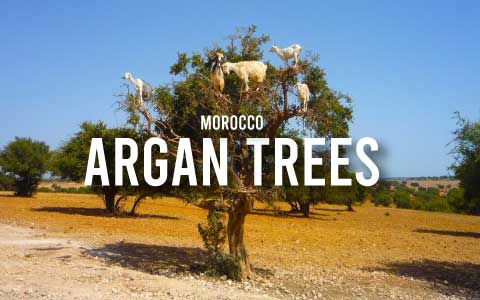
Discovering the Argan Forests and Tree-Climbing Goats
Morocco is a magical land, not only for the beauty of the Sahara Desert or the Agafay Desert, the Atlas Mountains, the Ourika Valley, the Dades Gorges, or kasbahs like Ouarzazate and ksars like Ait-Ben-Haddou. The cities boast fascinating historic palaces and vibrant souks. Essaouira is famous for its breezy beaches and vibrant arts scene, while Marrakesh captivates with its red palaces. However, one of the most unique and fascinating experiences awaiting you is a trip to the Argan forests, where goats can be seen skillfully climbing trees in search of food. This surreal sight is not only a natural wonder but also deeply connected to the local economy and culture. Here’s everything you need to know about this extraordinary phenomenon.
The Unique Relationship Between Goats and Argan Trees
The Argan tree (Argania spinosa) is an ancient species native to Morocco, particularly in the semi-arid regions of the country. Known for its resilience and ability to thrive in harsh climates, the Argan tree produces small, olive-like fruits that attract goats. Due to the scarcity of food in the dry landscape, goats have developed an incredible ability to climb the twisted branches of these trees, often reaching impressive heights to feast on the fruit and leaves.
This behavior is not only fascinating to observe but also plays a role in the Argan oil production process. After consuming the fruit, goats naturally help separate the pulp from the hard nut inside, which is later collected, cleaned, and processed to extract the valuable Argan oil. This oil is widely used in cosmetics and cooking, making it one of Morocco’s most prized natural products.
Where and When to See the Tree-Climbing Goats
The best place to witness this incredible spectacle is in the rural areas between Marrakesh and Agadir, where Argan trees are abundant.
When you embark on a tour to see the Argan forests and the tree-climbing goats, expect a scenic drive through Morocco’s countryside, with stunning views of rolling hills and traditional Berber villages. As you approach the areas where the goats are commonly seen, you’ll likely spot them perched on the gnarled branches, sometimes in large groups, making for an unforgettable photo opportunity.
Many guided tours can take you to these locations, often combining the experience with visits to Argan cooperatives where you can watch the traditional extraction process firsthand. These cooperatives, often run by local women, provide insight into how the nuts are cracked, ground, and pressed to produce the famous golden oil. You can take the opportunity to purchase authentic Argan oil products directly from these cooperatives, ensuring support for the local economy and avoiding counterfeit products found in some tourist markets.
Responsible Tourism
While the sight of goats in trees is undeniably captivating, it’s important to be aware of ethical concerns. Some farmers, recognizing the appeal to tourists, may place goats in trees for extended periods, which can be stressful for the animals. To ensure a responsible visit, do your research to find tours that prioritize ethical interactions and avoid those that exploit the goats purely for tourism.
One factor to consider is the season. The best time to see the goats climbing is during the dry season, typically from late spring to early autumn. This is when food is scarcer on the ground, prompting the goats to seek sustenance in the trees. Off-season tours may be artificially staged, forcing the goats into the trees unnaturally.
Once you reach the Argan forests, observe the goats from a distance rather than encouraging practices that might harm them. Always follow your guide’s instructions and avoid disturbing the goats or damaging the trees.
Why This Experience Is Worth It
Visiting the Argan forests and witnessing the tree-climbing goats is certainly an unusual and curious experience that will give you plenty of anecdotes to share once you return home. However, it is also a chance to connect with Morocco’s unique ecology, learn about the cultural significance of Argan oil, and gain a deeper appreciation for the ingenuity of both nature and local traditions.
To enjoy your experience at its best, remember to book a guided tour in advance. Many local agencies offer half-day or full-day trips, often including stops at Argan cooperatives and scenic viewpoints. Go early in the day, as morning visits often provide the best lighting for photography and cooler temperatures for a more comfortable experience. If your tour includes a walk through the Argan forests or a visit to a cooperative, comfortable footwear is recommended.



